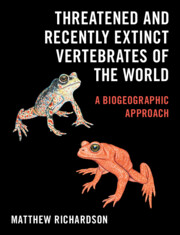Book contents
- Threatened and Recently Extinct Vertebrates of the World
- Threatened and Recently Extinct Vertebrates of the World
- Copyright page
- Dedication
- Contents
- Foreword
- Preface
- Acknowledgements
- Chapter 1 The Arctic Realm
- Chapter 2 The Palearctic Realm
- Chapter 3 The Afrotropical Realm
- Chapter 4 The Madagascan Realm
- Chapter 5 The Indo-Malaysian Realm
- Chapter 6 The Papua-Melanesian Realm
- Chapter 7 The Australian Realm
- Chapter 8 The Polynesian Realm
- Chapter 9 The Nearctic Realm
- Chapter 10 The Caribbean Realm
- Chapter 11 The Neotropical Realm
- Chapter 12 The Patagonian Realm
- Chapter 13 The Antarctic Realm
- Chapter 14 The Oceanic Realm
- Chapter 15 Global Balance
- Bibliography
- Index
Chapter 7 - The Australian Realm
Published online by Cambridge University Press: 24 February 2023
- Threatened and Recently Extinct Vertebrates of the World
- Threatened and Recently Extinct Vertebrates of the World
- Copyright page
- Dedication
- Contents
- Foreword
- Preface
- Acknowledgements
- Chapter 1 The Arctic Realm
- Chapter 2 The Palearctic Realm
- Chapter 3 The Afrotropical Realm
- Chapter 4 The Madagascan Realm
- Chapter 5 The Indo-Malaysian Realm
- Chapter 6 The Papua-Melanesian Realm
- Chapter 7 The Australian Realm
- Chapter 8 The Polynesian Realm
- Chapter 9 The Nearctic Realm
- Chapter 10 The Caribbean Realm
- Chapter 11 The Neotropical Realm
- Chapter 12 The Patagonian Realm
- Chapter 13 The Antarctic Realm
- Chapter 14 The Oceanic Realm
- Chapter 15 Global Balance
- Bibliography
- Index
Summary
The Australian Zoogeographic Realm comprises the island continent of Australia and nearby islands, the largest of which is Tasmania. There has long been much confusion over the terms ‘Australian’ and ‘Australasian’, and a number of competing definitions as to what exactly should be included within them. From a purely geological standpoint Australia, New Zealand and New Caledonia are all fragments of the ancient supercontinent Gondwana. These three landmasses have been separated from other continents, and from each other, for tens of millions of years. Australia, New Guinea, and Tasmania, for their part, are separated from one another by shallow continental shelves and were linked together when the sea level was lower during the ice ages. They therefore share a similar fauna, which includes marsupial and monotreme mammals and ratite birds (New Zealand also has ratite birds, the kiwis along with the now-extinct moas), along with certain common floristic elements. From a biogeographic perspective, however, the fauna and flora of Australia (together with Tasmania), New Guinea and New Zealand, while sharing the aforementioned similarities, are all highly unique in their own ways. They are accordingly treated here as separate. Australia itself seems to have been isolated by water barriers longer and more effectively than any other continent, except perhaps for Antarctica. This explains why it is so rich in unique animals of great scientific interest. Surrounded by the Indian and Pacific oceans, its great size gives it a wide variety of landscapes, with tropical rainforests in the north-east, mountain ranges in the east and south-west, and dry desert and semi-desert in the centre. It is mostly flat with few large rivers, and has therefore few geographical barriers to the spread of plants and animals. But there are climatic boundaries. Thus, low precipitation has had a tremendous influence. Practically the whole continent is arid, one-third of it having an annual rainfall not exceeding 25 cm and the average precipitation throughout Australia just 38 cm, with high evaporation. Only about one-third of the continent can be cultivated, chiefly in the coastal fringe that receives sufficient rainfall to grow crops or artificial pastures. Twenty-five per cent of Australia is desert and 47 per cent arid or semi-arid grassland. Despite this dry climate, the vegetation varies greatly, ranging from tropical in the north to temperate in the south. Australia’s relatively few woods and forests, which are unfortunately concentrated along the eastern coast (the most heavily populated area), are dominated by eucalypts. They grow in open or closed communities with thin or dense undergrowth of shrubs and herbs in wet or dry habitats. The resulting deforestation has had serious repercussions on the fauna, because many species were restricted to this habitat and others took refuge there when they were persecuted in the plains.
- Type
- Chapter
- Information
- Threatened and Recently Extinct Vertebrates of the WorldA Biogeographic Approach, pp. 319 - 340Publisher: Cambridge University PressPrint publication year: 2023



